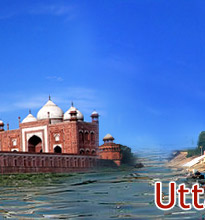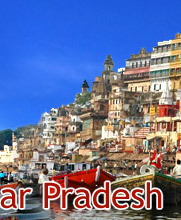 Lucknow,
the city of Nawabs, has numerous tourist attractions on offering for
you. The city that is equally famous for its culture and culinary has a
laid back image and the favorite pastime of people in the city is to sit
across any of its numerous food-joints & gossip. Following are some
of the famous attractions in Lucknow: -
Lucknow,
the city of Nawabs, has numerous tourist attractions on offering for
you. The city that is equally famous for its culture and culinary has a
laid back image and the favorite pastime of people in the city is to sit
across any of its numerous food-joints & gossip. Following are some
of the famous attractions in Lucknow: -Bada Imambara
Bada Imambara is a famous monument of Lucknow that has historical, cultural and heritage importance. Bada Imambara complex was commissioned by the then Nawab of Awadh, Asaf -ud-Daula in the year 1784. The complex also includes the large Asfi mosque, the Bhul-Bhulayah (the labyrinth) and a summer palace with running water.
Chota Imambada
Chota Imambara is the landmark of Lucknow. This monument is also known as Husseinabad Imambara in Lucknow as this place was the office of the erstwhile Husseinabad trust that owned the city once. Chota Imambara is an imposing monument located in the Old City area of Lucknow close to Chowk.
Government Museum
The State Museum in Lucknow is a must visit for all the tourists and otherwise who visit Uttar Pradesh. Lucknow Museum is rather situated in a modern three-storied building at Banarasi Bagh area of Lucknow. It is actually a museum and archive rolled in one. The museum has separate galleries dedicated to sculptures, bronzes, paintings, natural history and anthropological specimens, coins, textiles and decorative arts.
Rumi Darwaza
Rumi Darwaza is one of the most impressive gateways not only in Lucknow or India but also the whole world. The gateway lays Northwest of Bada Imambara. It is interesting to note that Nawab Asaf-ud-Daula, like the Bada Imambara, also commissioned Rumi Darwaza. Both were commissioned under the 'Food for Work' program initiated by the Nawab to bring respite to the city populace that was suffering from famine
Shah Najaf Imambara
Shah Najaf is the pseudonym given to Maula Ali, the son-in-law of Prophet Muhammad who was the most valiant warrior and the greatest intellectual of Islam. His nickname was Haider that means Lion in Arabic. Due to his valiant efforts in protecting the nascent Islam, he was bestowed with the title of Haider-e-Khuda or "Lion of Allah". Ali later became the fourth Caliph of Islam. During his caliphate he chose Najaf, a town in Iraq, as his seat of governance.
The Residency
The Residency is actually a group of buildings that were built in 1800 A.D by the then Nawab of Oudh, Nawab Saadat Ali Khan. It was constructed in order to serve as the residence for the British Resident General who was a representative in the court of Nawab. The palace was rather a sleepy residence for decades but then came an incident, which put it on the world map.









